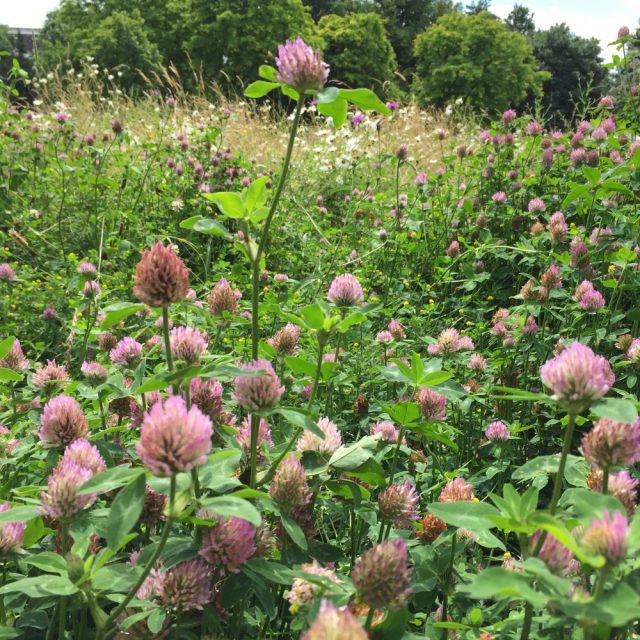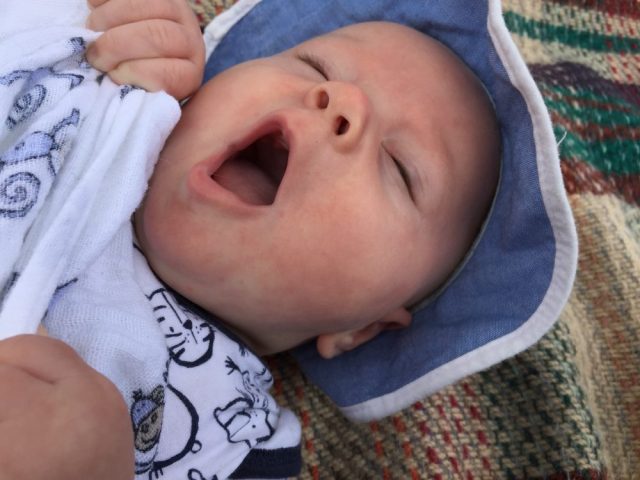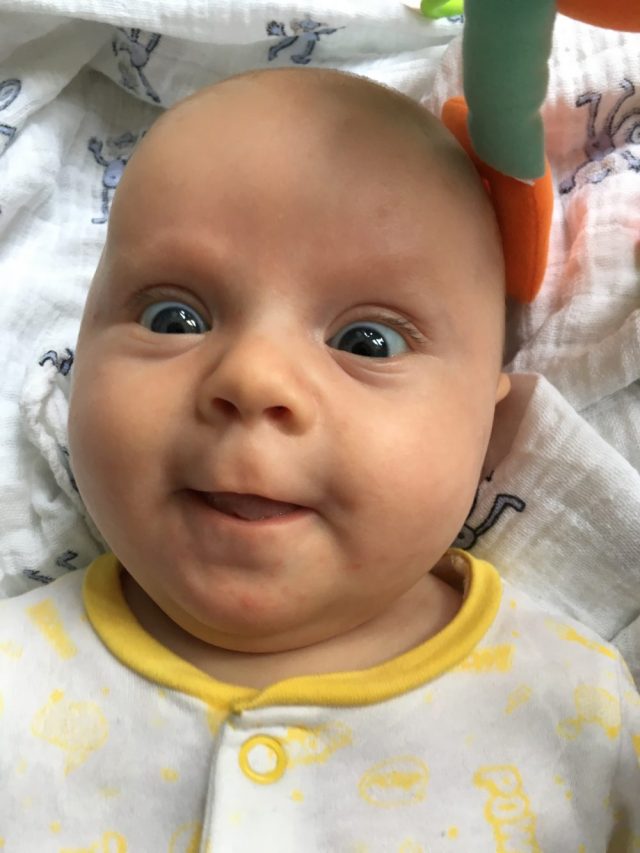Writing is difficult at the moment. It’s rare that I get the chance to sit down and type without Tommy’s eyes popping open and requiring attention. But here are a few photos from my walks round the local parks and Kew Gardens.
Red clover
An important plant for bees, particularly bumblebees. Clover florets (florets are the individual flowers that make up the flower head) drop once pollinated so that bees know not to bother visiting them. When red clover first flowers it has too deep a flower for a honey bee to reach the nectar, but if the clover is cut and then grows back, the flowers are shorter and can be accessed by honey bees.
White clover
The legume family, including clovers, vetches and trefoils, have special bacteria in their root nodules. These bacteria are able to turn nitrogen from the air into nitrates that enable the plants to manufacture protein for growth – in other words, they make their own fertilizer. This means they can afford to put more protein into their pollen, making it especially nutritious to bees.
White clover nectar is also very important for bees. According to an information board I saw recently at Kew Gardens, white clover contributes more nectar than any other plant species in the UK. Elizabeth Gowing describes clover honey in her ‘Little Book of Honey‘ as “sweet and light, with a citrus tang which changes to a sourish aftertaste that stops it being sickly to eat”.
Ragwort
When I think of July flowers, I think of yellows and purples. Bright yellow ragwort flowers grow alongside members of the thistle family in all the wilder parts of my local park. They’re tough and can grow on waste land, road sides, rough grassy areas etc. The plants are an important food source for orange & black striped Cinnabar moth caterpillars. Ragwort contains toxic alkaloid substances, which the caterpillars cleverly absorb and assimilate, to become unpalatable to predators.
Celia Davis in The Honey Bee Around & About (2007) describes ragwort as being “very attractive to bees… likely to produce quantities of extractable honey which smells horrible when it is fresh. If it is allowed to stand and granulate, the flavour improves and some beekeepers use it to blend with other, less flavoursome honeys.”
Clive de Bruyn is also positive about ragwort honey, commenting in his classic book Practical beekeeping (1997) “The honey is a deep yellow with a strong flavour thought by some to be obnoxious. I personally find that it adds a bit of interest.” Has anyone reading tried it?
Some more yellow flowers below – a sunflower, the one with pink petals I think is a species of echinacea and I’m not sure what the flower with a bumble bee in the middle is called – any ideas?
Presumably it is the sunflower nectar the bees are after, as a number of experts I’ve heard speak have said that sunflower pollen contains a particularly poor percentage of crude protein – only around 13% compared to 22-24% for an average pollen.
Thistles, teasels and knapweeds
I find the different members of the thistle and teasel family hard to tell apart. They come in various shades of purple and levels of prickliness! Below are photos of a bumblebee on what I think is common teasel and a honey bee on what I think is a species of thistle. Teasel seeds are an important winter food for some birds, such as goldfinches. Interestingly there is some evidence that teasels may be partially carnivorous and able to absorb nutrients from dead insects in rainwater which gathers in a cup-like receptacle formed by leaves on their stem – see ‘Carnivory in the Teasel Dipsacus fullonum — The Effect of Experimental Feeding on Growth and Seed Set‘.
The pics below were taken by Drew on a better quality camera, as you can tell. I’m not quite sure what purple flowers these are, so if you do know please leave a comment!
Some more purple flowers – verbena, cornflower and globe thistle.
Himalayan balsam
Recognise this? It grows in watery areas, so you can see it along the edge of canals and rivers. An invasive weed, but useful for beekeepers. It leaves a light grey pollen stripe on the middle of a honey bee’s back, the part she can’t quite reach to clean.
Blackberry bramble
Over now in London, but the flowers continued during early July. We have blackberries available to pick already. It grows everywhere of course so is very useful for our bees. Did you know that there is a special word for the scientific study of brambles – batology?
Homo sapiens
A young and sprightly example of the human genus. Not known to attract bees. Does gain attention from elderly ladies on the bus.




















Gorgeous baby pics! You ask about a few plants: the yellow one is hypericum and I’d guess the round purple-pink ones are a type of allium. My honey bees have been visiting persicaria and passion flowers recently. The bumbles are loving my yellow buddleja. I’ve let a few artichokes flower – a giant thistle – again, the bumbles are visiting.
LikeLike
Thanks for ID’ing them! Your garden sounds lovely.
LikeLike
Lovely pictures, Emily, and it is nice to see that you are out and about enjoying the summer with Tommy. He is at a lovely age and I hope you enjoy your precious time with him.
Funny you mention red clover. Last summer the fields around us here in France had very limited amount of red clover. This year both red and white clover was in abundance. Even in our back garden we had large patches of clover growing that I left uncut as both our honey bees as well as Amelia’s solitary bees and bumbles were feasting on. May be the heavy rain in June brought out the clover.
Two more weeks and I hope to remove the supers to collect our summer honey.
Best wishes to you and your family.
LikeLike
Thank you Kourosh. Glad to hear you have lots of clover around you. It will be very exciting to collect your clovery summer honey. Once the supers are off that will be a good opportunity to treat with Apiguard or another anti-varroa treatment so that the first winter bees being born are in good shape.
LikeLike
Well done for getting a bumble on the Hypericum, I get nothing on my large bush. I am trying other species but they will not flower before next year. The other unknown purple-pink could be chives. Amelia
LikeLike
Surprising that the bees don’t visit your Hypericum but perhaps they are too spoilt for choice in your magnificent garden!
LikeLike
I’m digging that bush out and I am planting other species which I have been told attract bees 🙂
LikeLiked by 1 person
What a face! The flowers are lovely, too. Right now our prairies are predominantly yellow flowers and the bees are loving it. Queen Anne’s lace is also blooming but seems to be preferred more by the paper and potter wasps, tiny bees, and a few beetles.
LikeLike
Thanks Mark. Would love to visit your prairies one day.
LikeLiked by 1 person
Very cute kid. The flowers are nice as well. Nicely done, on all counts.
LikeLike
Thank you, though my attempts at flower photography are embarrassing compared to yours.
LikeLike
Don’t sell yourself short. And, your portrait photography leaves me in the dust.
LikeLike
Really enjoy reading your posts. This one’s especially dandy with the nectary flowers, great photos, botany bits, and finally the unexpected lagniappe at the end! Thanks!
LikeLike
Thanks Ron – and thanks for the unexpected gift of teaching me a new word – lagniappe!
LikeLike
As another lagniappe, here’s the history of the word:
https://ahdictionary.com/word/search.html?q=lagniappe
LikeLike
I have a few artichokes which I think qualify as thistles, but I think I have a very small thistle in my drive. Great photos, nice looking boy!
LikeLike
Thanks 🙂
LikeLike
Gorgeous baby, nice of you to share his little face with us! I have just bought my first hive to install in my back garden. I’ve really enjoyed reading your blog and in particular your identification of the different bees, which I have now started to do in my own garden. Thank you. 😊
LikeLike
Thank you Simone, how exciting that you are starting out with bees, you will have so much fun watching them in your garden!
LikeLiked by 1 person
That’s a great eye-popping picture you concluded with.
The kind of white clover you showed here is a fixture in the lawns of people all across America, including the lawn I grew up with on Long Island, east of New York City. I had no idea then that the clover, like the ubiquitous dandelions that accompanied it, was from Eurasia.
LikeLike
Lovely flowery post Emily, I’m sure you’re loving being out and about enjoying the flowers with your gorgeous baby son- at least he’s not mobile yet -this time next year he’ll probably be walking and be into everything so you’ll have even less time to sit and write peacefully!
LikeLike
Children and the moments we have with them are one of the few gifts that even in our worst moments we know are the most special things we will ever be given.
LikeLike